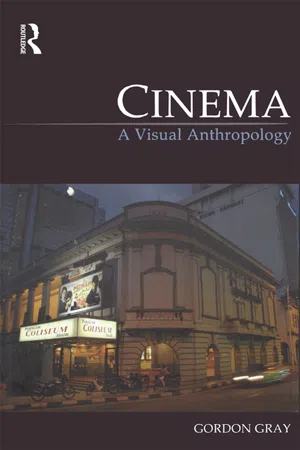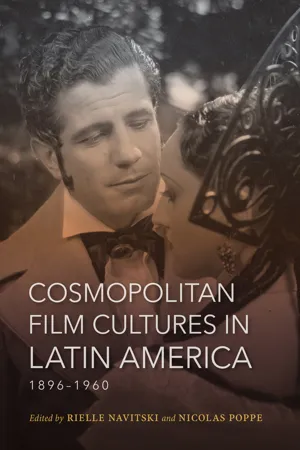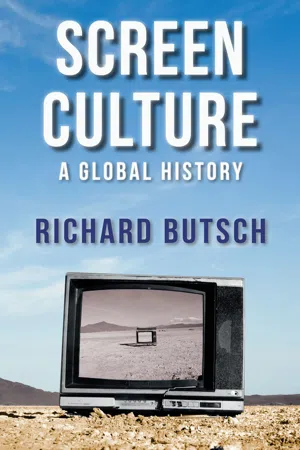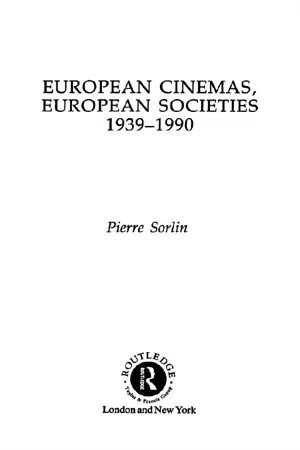History
Hollywood Golden Age
The Hollywood Golden Age refers to a period in the American film industry from the 1920s to the 1960s, characterized by the dominance of major studios and the production of classic films. It was a time of glamorous movie stars, iconic directors, and groundbreaking technological advancements, leading to the creation of timeless cinematic masterpieces that continue to influence popular culture today.
Written by Perlego with AI-assistance
Related key terms
Related key terms
1 of 4
Related key terms
1 of 3
4 Key excerpts on "Hollywood Golden Age"
- eBook - ePub
Cinema
A Visual Anthropology
- Gordon Gray(Author)
- 2020(Publication Date)
- Routledge(Publisher)
neo-realism in Italy, and national cinema in several places around the world were actively opposed to what they saw as facile and irrelevant films swamping the world’s cinemas (Parkinson 1995: 125–6, 185–95; Morandini 1996a; Vincendeau 1996; Cousins 2004: 186–216). Some nation-states were also concerned with the influx of American films, and various censorship policies and financial restrictions, like import tariffs, were put in place to control the access to or markets for American films. Possibly for the above reasons, the Golden Age of Hollywood either overlapped with or preceded the Golden Age for several other cinema industries, many of which also employed a variation of the Hollywood studio system. While the Golden Ages for different countries were different, the period from the 1940s to the 1960s was a vibrant period for most cinema industries. Most of the Hollywood stars and famous directors of this period are well known enough to forgo in-depth treatment here, but there were many other important filmmakers outside of the Hollywood system. Indeed, two of the most famous non-Euro American filmmakers were of this era.Figure 1.7 An example of the Golden Age “Picture Palace” - the Eros Cinema Mumbai, India. Built in 1938. Photograph by Madhav Pai 2008.Case Study: Satyajit Ray and Akira KurosawaAkira Kurosawa and Satyajit Ray are two very different filmmakers who also share some surprising similarities. Kurosawa had seen over 100 foreign films by the time he was nineteen, in 1929 (Richie 2005: 28). Ray was born into a politically active family and initially worked as an advertising illustrator (Rajadhyaksha 1996: 682). As filmmakers, however, they both had to negotiate combining a Western developed media with their own cultural traditions and expectations. They also had to negotiate developing their artistic visions, while working under very powerful studio systems. That they both succeeded speaks highly for their abilities to make that negotiation. - Rielle Navitski, Nicolas Poppe(Authors)
- 2017(Publication Date)
- Indiana University Press(Publisher)
Film historians like Carl J. Mora correctly note that the Golden Age is possible thanks to the emergence of a star system, but the repertoire of topics one finds in mainstream accounts still reflects a preference for icons closely related to topics like comedia ranchera, barrio portrayals, and melodramas. 11 Still, even in the most canonical of criticism there is recognition of the effect of foreign influences, mostly as a result of the flows between US and Mexican cinema, and even of open attempts by Hollywood to obstruct the dominance of Mexican productions in both the local market and the Spanish-language market at large. 12 In a recent study, Andrew Paxman describes well the institutional paradox that underlies the arguments in my analysis. Paxman recognizes that, even though cultural nationalism was alive and well as expressed in some of the most important films by Emilio Fernández and Ismael Rodríguez, “the goal of cultural nationalism—in terms of healthy local output and protection from foreign product—was partly compromised in favor of free market forces, from which Hollywood, the president and his cronies stood to benefit.” 13 Beyond the historical details described by Paxman, such as the emergence of the Banco Cinematográfico, the relevant point for my purposes is that the process of cultural modernization rendered a cinematic culture that came into quick tension with the Mexicanist culture promoted by the post-revolutionary regime. This was due to the need of opening culture to the same kind of free-market processes that the rest of the economy was fostering- eBook - ePub
Screen Culture
A Global History
- Richard Butsch(Author)
- 2019(Publication Date)
- Polity(Publisher)
3 The Hollywood Studio Era, 1910s–1940sIn 1926, William Seabury, General Counsel to the Motion Picture Board of Trade and the National Association of the Motion Picture Industry, quoted Thomas Edison saying, “whoever controls the motion picture industry controls the most powerful medium of influence over the people.”1 In this era film was the screen medium in America, a highly organized, vertically integrated oligopoly, with annual ticket sales in the billions. The basic characteristics of the industry, including its relocation in Hollywood, began to emerge by the mid 1910s. The mature economic and cultural formation, the Hollywood studio system, would remain dominant and essentially unchanged for three decades, until the US government dismantled the vertical integration and television arrived after World War II.2A handful of Hollywood studios had centralized control of film production, distribution and exhibition. They shaped what films were made, how much each was promoted and distributed, and in what circumstances each was viewed. They even colonized other entertainments, such as the Broadway theater and recorded music industries, to feed its maul. Most important, the concentration of Hollywood decision-making and routinization of production resulted in a uniformity in style of Hollywood films from the 1920s to the 1960s. Noting this, French auteur François Truffaut said, “We love the American cinema because the films all resemble each other.”3 Such consistency and repetition did much to naturalize underlying viewpoints, values and beliefs encoded in these films, making them a greater influence on American screen culture and on American culture generally than they otherwise may have been.At the same time, Hollywood succeeded in containing the controversy and criticism that had constituted a national discourse before this consolidation. Movie-going became a normal part of American everyday life. Audiences were uncontroversial and only sporadically surfaced in public discourse. This was demonstrated by the mild reception to the thirteen-volume Payne Fund Studies published in 1933, probably still the largest single research effort to document the effects of film on child audiences.4 - eBook - ePub
- Pierre Sorlin(Author)
- 2004(Publication Date)
- Routledge(Publisher)
3 A GOLDEN AGE
The decade which followed the Second World War was a Golden Age for the film exhibitors. Let us forget for a moment that in Britain film attendance began to decrease as early as 1948. In Europe 1955 saw the peak of cinema admissions: more than 3,000 million tickets were bought, which means that, statistically, every European, including the new-born, went to the movies sixteen times. I must admit that my figures are to a large extent artificial since they combine those of different countries. Contrasts between nations regarding entertainment as a whole, and more specifically film consumption, are important and extremely instructive. But seen from outside—say from Hollywood which at the time was losing a large proportion of its domestic clients1 —Europe was a wonderful market, ready to swallow an enormous quantity of cinematic productions. As film history is generally organized according to the divisions between languages and national boundaries, little has been said up to now about this extraordinary juncture which Europe went through in the 1950s, and it is hard for us to realize that this passing fancy (it did not last more than fifteen years) was common to the whole continent. Also it is said that the movies made at the time were not exceptionally good. However, we are not concerned here with judging their quality but with understanding the relationship between the Europeans and their cinemas, and as soon as we take a look at the statistics we guess that something unusual happened during these years. This is what I would like to throw some light on in this chapter.VISITING THE PICTURE-HOUSES
In the 1930s the ‘circuits’—the big or small companies which owned the film-theatres—had built in the American fashion luxurious picture-palaces, the famous ‘domes of pleasure’ in which the patrons were supposed to have dreamt, for a few hours, of a brilliant, exciting life which in fact was not theirs. At the end of the 1940s the cinemas which had not been redecorated for a long time looked a bit dilapidated, they were badly heated in winter, their seats were often defective and their carpets worn out, but the circuits did not bother to restore them since there were long lines of clients waiting outside the doors. The Europeans were so anxious to go to the pictures that new picture-houses appeared even in the smallest towns; in the 1950s an extra 1,000 cinemas opened in France, another 1,000 in Germany and 3,000 in Italy. Researchers have excavated the archives of the local cinemas throughout the continent so that we now have a reasonably good vision of film exhibition in the post-war era.2
Index pages curate the most relevant extracts from our library of academic textbooks. They’ve been created using an in-house natural language model (NLM), each adding context and meaning to key research topics.
Explore more topic indexes
Explore more topic indexes
1 of 6
Explore more topic indexes
1 of 4



